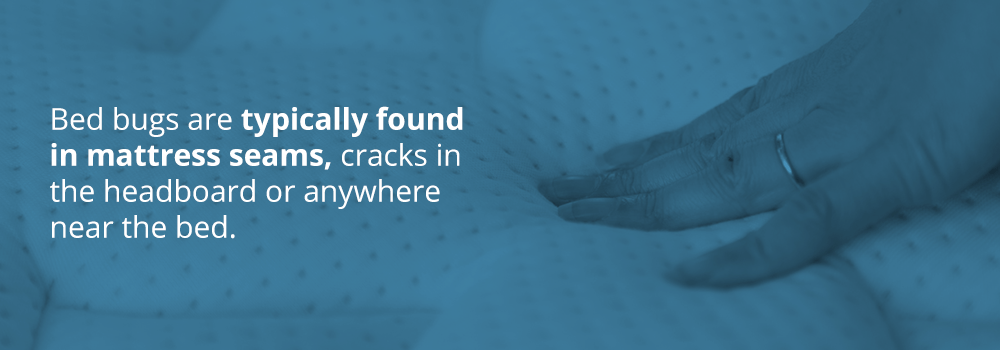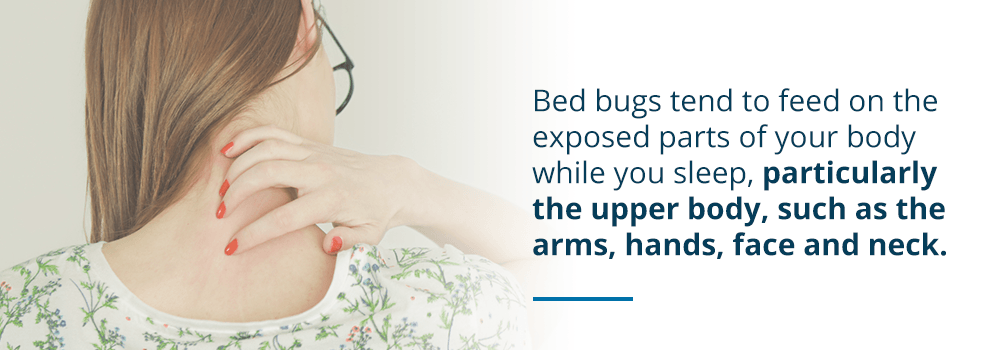Chapter 2: Signs of Bed Bugs
If you’ve ever woken up with a mysterious bug bite, you’ve probably wondered if you have bed bugs. Many different insects cause itchy bites, from spiders to mosquitoes. So, how do you know if you have bed bugs or were bitten by some other creepy-crawly?
In this chapter, we’ll look at the various bed bug signs and symptoms to help you determine if you have an infestation or are being pestered by a different insect. If you need help identifying any bug you’re concerned about in your home, reach out to us at Pestech Pest Solutions. We’ll be happy to identify the nuisance and offer solutions.
Contact Pestech Today
What Is the First Sign of Bed Bugs?
You might not notice you have a bed bug infestation until you find bite marks on your body, especially ones you can’t explain. However, since bite marks can take as long as two weeks to show up in some people, you’ll want to look for other signs first, such as blood spots on your sheets or live bugs.
You’ll want to check for bed bugs after you stay in a hotel, resort or any place that sees a lot of overnight visitors. Make sure to check your bags or purse if you visit any area with a known infestation.
How to Tell If You Have Bed Bugs
While it might not be apparent right away that you have an infestation, you can still look for clues. If you have a bed bug infestation, you might notice the following signs:
- Reddish stains on the mattress, sheets or pillowcases where bed bugs were crushed
- Bed bug droppings, which may appear as tiny, dark spots
- Bed bug eggs, eggshells and yellowish skins left behind by nymphs
- A musty odor
Sometimes, the best thing you can do is to look for the bed bugs themselves.
How to Look for Bed Bugs

Bed bugs are typically found in mattress seams, cracks in the headboard or anywhere near the bed. However, bed bugs are willing to travel as much as 20 feet from their hiding spots to feed on their host if necessary, so you’ll want to check other potential hideouts.
To look for bed bugs, first, gather the following tools:
- Flashlight
- Magnifying glass
- A long, flat tool for probing such as a nail file, spatula or putty knife
- A vacuum cleaner with a crevice attachment
- Gloves
- Paper towels
After you have your tools, take these steps to search for bed bugs in sleeping areas:
- Carefully move your flashlight beam along all cracks and crevices, looking for live or dead insects, skins, eggs, droppings or stains.
- Insert a putty knife or other probe into cracks to make bed bugs come out.
- Be sure to check all parts of the bed, including the mattress, box spring, frame, headboard, footboard and bedding.
- Examine all areas near the bed, including furniture, walls, curtains, trim and decorations.
- Vacuum any bugs you find along the way, and consider saving a few as a sample.
- You can also crush bed bugs with the paper towels.
If you don’t discover any bed bugs during your investigation but are worried you may have overlooked them, reach out to a pro for help. If you capture a few insects but aren’t sure if they are bed bugs, you can show a sample to a pest control service or send one to an entomologist.
Lastly, if you’re pretty sure you’ve found bed bugs, it’s important not to panic. Do not move any furniture or throw items away, and avoid running to the store to grab DIY pesticides. Instead, try to stay calm so you can take the right course of action.
How to Identify Bed Bug Bites
It can be challenging to tell the difference between bed bug bites and other insect bite marks, especially spider and mosquito bites. Though the signs and symptoms can vary between individuals, here’s what bed bug bites look like in general:
- Raised red bump that may have a dark red or clear center
- May be random or appear in a line or cluster
- May be swollen around the bite
According to the American Academy of Dermatology (AAD), bed bug bites often appear in a zigzag pattern and contain clusters of three to five bites. Bites can appear individually, though, so it’s important not to cross bed bugs off the list of possibilities if you wake up with a single bite.
Where Do Bed Bugs Bite?

Bed bugs tend to feed on the exposed parts of your body while you sleep, particularly the upper body, such as the arms, hands, face and neck. However, bed bugs really aren’t fussy eaters and will bite any part of your body as long as they can get a blood meal. Bed bugs can also bite under loose clothing, though they prefer exposed skin.
How Long Do Bed Bug Bites Last?
According to the AAD, bed bug bites typically heal and disappear within a week or two, and you can usually treat them at home. If the bites lead to an infection, or if you have an allergic reaction or a large number of bites, the AAD recommends getting them looked at by a medical professional.
Can You Feel When a Bed Bug Is on You?
Although bed bugs might make you itch as they crawl on you, you’ll not likely feel them. This is because bed bugs are tiny and typically crawl on you while you’re asleep. Both adults and nymphs also only take about five minutes to eat and run back to their hiding spots when they’re done. So, unless you catch them while they’re feasting, you may never know they stopped by. Bed bugs also don’t feed every day, and usually eat every five to 10 days.
You also won’t likely feel them bite because when they do, they inject an anesthetic to numb the pain and keep their presence a secret. Their numbing saliva is the same substance that might cause a reaction in your skin and lead to itchy bumps.
With all that said, if you happen to be awake when they come out for a meal, you might notice them just like any small bug on the skin.
Can You Have Bed Bugs and Not See Them?
Bed bugs spend up to 95% of their time in hiding, and not everyone reacts to bites, so it is possible to have them and not see them. It may seem surprising, but a lot of people might not realize they have an infestation. For example, according to a study published in the Journal of Medical Entomology, nearly half of the study’s participants weren’t aware of the bed bug activity in their homes.
People who do not react to bed bug bites might not realize they have an infestation until it’s large. With a heavy infestation, you might spot a bed bug during the day in areas away from your bed or notice an intense, unpleasant odor.
Whether you have bed bugs or not, there’s no need to wonder or worry — reach out to a pro, and they’ll figure out if there’s an issue.
